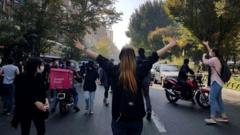In recent days, the youth of Iran find themselves ensnared in a complex dialogue about freedom and foreign intervention. With Israel's air strikes targeting Iranian military locations, Prime Minister Benjamin Netanyahu’s attempts to redefine these actions as liberation calls have sparked controversy among young Iranians. While some rally behind his statements promising “freedom,” others criticize his motives.
Historically, Iran has witnessed stringent bans on opposition movements, particularly since the mass executions of the 1980s, which left the remaining dissidents largely scattered abroad. The two prominent groups operating outside Iran—the pro-Shah monarchists and the Mojahedin-e Khalq Organisation—have not gained significant traction within the country due to ongoing state repression.
Access to the internet and social platforms has been severely limited by the Iranian authorities, making it a struggle for journalists to connect with citizens. However, a few young dissidents have voiced their thoughts, albeit with anonymity for safety reasons. Tara, a 26-year-old, reported that the authorities often cut internet access before Israeli strikes to keep the population uninformed, allowing the government to blame any rising fatalities on foreign interventions rather than their systemic oppression.
The sentiments vary significantly among the youth. Sima, 27, admits to feeling drained and wishes for decisive action against the Islamic Revolutionary Guard Corps (IRGC). She is ambivalent about Israeli involvement, expressing a desire for rapid change, regardless of the means. Meanwhile, Amir, 23, openly supports the airstrikes, viewing them as the only effective response against the regime, a stark contrast to those who fear that such violence could turn the populace against Israel.
Among the voices of dissent, activists like Navid, 25, underscore a critical concern; the fear that any confrontation could bring devastation to ordinary citizens, potentially igniting sympathy for the regime. Darya, 26, highlights the apathy towards protests, stating that many are not inclined to act even in the face of aggression, as they perceive Netanyahu's calls for unity as a facade masking imperialist tendencies.
The anguish mounts for individuals like Arezou, 22, who finds herself torn between resentment towards the Iranian regime and mistrust of external entities like Israel. Her thoughts resonate with the overarching sentiment that fears of collateral damage and loss of innocent lives paint a grim picture. The quest for freedom, they argue, should not come at the expense of further violence.
Mina, 27, underscores the broader yearning for a solution that transcends warfare and death, invoking a plea for righteousness in a world where choices appear increasingly desperate. “We deserve a better way out than this,” she states, encapsulating a collective hope that safety and peace can emerge without sacrifice to innocent lives.
This conflicting array of emotions among young Iranians underscores the deep-rooted complexities of their struggle for liberation, caught in the crossfire of regional conflict and power plays.
Historically, Iran has witnessed stringent bans on opposition movements, particularly since the mass executions of the 1980s, which left the remaining dissidents largely scattered abroad. The two prominent groups operating outside Iran—the pro-Shah monarchists and the Mojahedin-e Khalq Organisation—have not gained significant traction within the country due to ongoing state repression.
Access to the internet and social platforms has been severely limited by the Iranian authorities, making it a struggle for journalists to connect with citizens. However, a few young dissidents have voiced their thoughts, albeit with anonymity for safety reasons. Tara, a 26-year-old, reported that the authorities often cut internet access before Israeli strikes to keep the population uninformed, allowing the government to blame any rising fatalities on foreign interventions rather than their systemic oppression.
The sentiments vary significantly among the youth. Sima, 27, admits to feeling drained and wishes for decisive action against the Islamic Revolutionary Guard Corps (IRGC). She is ambivalent about Israeli involvement, expressing a desire for rapid change, regardless of the means. Meanwhile, Amir, 23, openly supports the airstrikes, viewing them as the only effective response against the regime, a stark contrast to those who fear that such violence could turn the populace against Israel.
Among the voices of dissent, activists like Navid, 25, underscore a critical concern; the fear that any confrontation could bring devastation to ordinary citizens, potentially igniting sympathy for the regime. Darya, 26, highlights the apathy towards protests, stating that many are not inclined to act even in the face of aggression, as they perceive Netanyahu's calls for unity as a facade masking imperialist tendencies.
The anguish mounts for individuals like Arezou, 22, who finds herself torn between resentment towards the Iranian regime and mistrust of external entities like Israel. Her thoughts resonate with the overarching sentiment that fears of collateral damage and loss of innocent lives paint a grim picture. The quest for freedom, they argue, should not come at the expense of further violence.
Mina, 27, underscores the broader yearning for a solution that transcends warfare and death, invoking a plea for righteousness in a world where choices appear increasingly desperate. “We deserve a better way out than this,” she states, encapsulating a collective hope that safety and peace can emerge without sacrifice to innocent lives.
This conflicting array of emotions among young Iranians underscores the deep-rooted complexities of their struggle for liberation, caught in the crossfire of regional conflict and power plays.


















